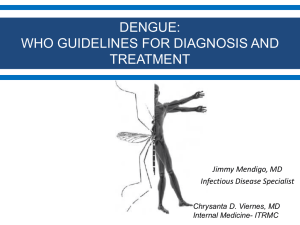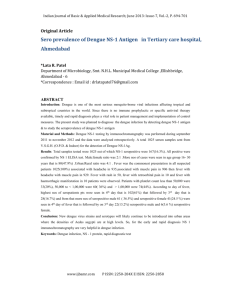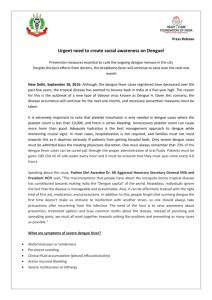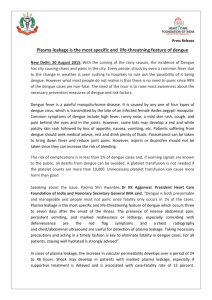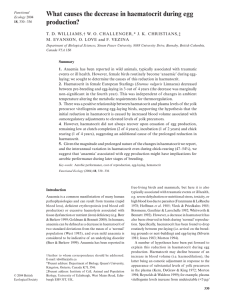file - BioMed Central
advertisement
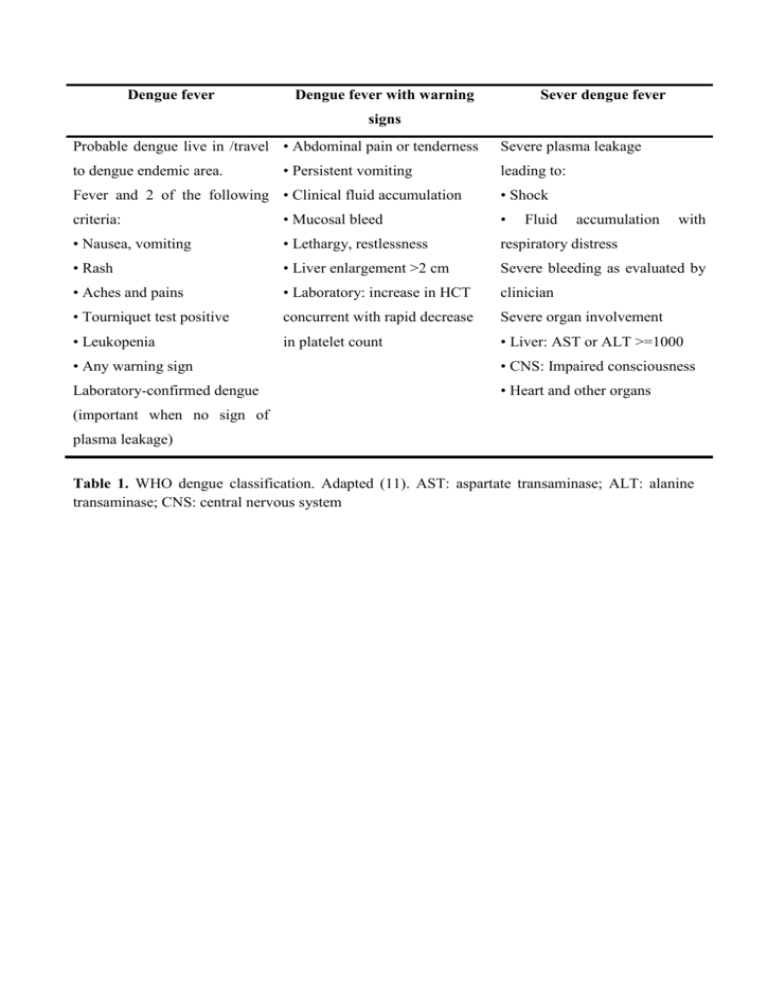
Dengue fever Dengue fever with warning Sever dengue fever signs Probable dengue live in /travel • Abdominal pain or tenderness to dengue endemic area. • Persistent vomiting Fever and 2 of the following • Clinical fluid accumulation Severe plasma leakage leading to: • Shock criteria: • Mucosal bleed • Fluid accumulation with • Nausea, vomiting • Lethargy, restlessness respiratory distress • Rash • Liver enlargement >2 cm Severe bleeding as evaluated by • Aches and pains • Laboratory: increase in HCT clinician • Tourniquet test positive concurrent with rapid decrease Severe organ involvement • Leukopenia in platelet count • Liver: AST or ALT >=1000 • Any warning sign • CNS: Impaired consciousness Laboratory-confirmed dengue • Heart and other organs (important when no sign of plasma leakage) Table 1. WHO dengue classification. Adapted (11). AST: aspartate transaminase; ALT: alanine transaminase; CNS: central nervous system Febrile phase Dehydration; high fever may cause neurological disturbances and febrile seizures in young children Critical phase Shock from plasma leakage; severe haemorrhage; organ impairment Recovery phase Hypervolaemia (only if intravenous fluid therapy has been excessive and/or has extended into this period) Table 2. The three classic phases of dengue fever. Adapted from WHO (11) History – date of onset of fever/illness; – quantity of oral intake; – assessment for warning signs; – diarrhoea; – change in mental state/seizure/dizziness; – urine output (frequency, volume and time of last voiding); – other important relevant histories, such as family or neighbourhood dengue, travel to dengue endemic areas, co-existing conditions (e.g. infancy, pregnancy, obesity, diabetes mellitus, hypertension), jungle trekking and swimming in waterfall (consider leptospirosis, typhus, malaria), recent unprotected sex or drug abuse (consider acute HIV seroconversion illness). Physical examination – assessment of mental state; – assessment of hydration status; – assessment of haemodynamic status; –checking for tachypnoea/acidotic breathing/pleural effusion; –checking for abdominal tenderness/hepatomegaly/ascites; –examination for rash and bleeding manifestations; – tourniquet test Investigations Full blood count should be done at the first visit Haematocrit test in the early febrilephase establishes the patient’s own baseline haematocrit White blood cell count A decreasing white blood cell count makes dengue very likely. Platelet count A rapid decrease in platelet count in parallel with a rising haematocrit compared to the baseline is suggestive of progress to the plasma leakage/critical phase of the disease. Liver function, electrolytes, urea glucose, and serum Evaluate organ disfunction creatinine, bicarbonate, lactate, cardiac enzymes, ECG and urine specific gravity. Disease notification Laboratory confirmation is not necessary before notification, but should be obtained. Table 3. Clinical-laboratoristic approach to a child with suspected dengue fever. Adapted (11). ECG: electrocardiogram. Good practice Bad practice Assessment and follow-up of patients with non-severe Sending patients with non-severe dengue home with no dengue and instruction of warning signs to watch out for follow-up and inadequate instructions Administration of paracetamol for high fever if the patient Administration of acetylsalicylic acid (aspirin) or is uncomfortable ibuprofen Obtaining a haematocrit level before and after fluid Not knowing when haematocrit levels are taken boluses with respect to fluid therapy Clinical assessment of the haemodynamic status before No clinical assessment of patient with respect and after each fluid bolus to fluid therapy Interpretation of haematocrit levels in the context of fluid Interpretation of haematocrit levels independent administered and haemodynamic assessment of clinical status Administration of intravenous fluids for repeated Administration of intravenous fluids to any patient vomiting or a high or rapidly rising haematocrit with non-severe dengue Use of isotonic intravenous fluids for severe dengue Use of hypotonic intravenous fluids for severe dengue Giving intravenous fluid volume just sufficient to Excessive or prolonged intravenous fluid maintain effective circulation during the period of plasma administration for severe dengue leakage for severe dengue Avoiding intramuscular injections in dengue patients Giving intramuscular injections to dengue patients Intravenous fluid rate and frequency of monitoring and Fixed intravenous fluid rate and unchanged frequency of haematocrit measurement adjusted according to the monitoring and haematocrit measurement during entire patient’s condition hospitalization for severe dengue Close monitoring of blood glucose Not monitoring hyperglycaemic blood effect glucose, on unaware osmotic diuresis confounding hypovolaemia Discontinuation or reducing fluid therapy once Continuation and no review of intravenous haemodynamic status stabilizes fluid therapy once haemodynamic status stabilizes Careful evaluation of clinical warning signs No evaluation of new clinical warning signs Careful evaluation of laboratory warning signs No evaluation of laboratory warning signs Table 4. Good and bad practice for a clinician dealing with a case of dengue fever. of the and


